- Welcome from the Head of College
- Current Undergraduate Students
- Graduate Studies
- Future Students
- International Students
- Research
- CACSSS Research Areas
- Research Impact
- Atlas of the Irish Revolution
- False Memories for Fake News in the Irish Abortion Referendum
- Atlas of the Great Irish Famine 1845-1852
- Hidden Galleries
- Movie Memories
- Between Two Unions: The constitutional future of the islands after Brexit
- Archive
- A Socio-Economic Study of Cork City Northwest Quarter Regeneration (CNWQR)
- Children’s Voices in Housing Estate Regeneration
- Cork Folklore Project
- Deep Maps: West Cork Costal Cultures
- Developing research to deliver high impacts in homelessness service provision by Cork Simon
- Moving On Ireland
- Project DaRT - Discussions and Reflections on Translation
- The Cork Folklore Project’s Memory Map
- The World-Tree Project
- The Augustinian Friars in Late Medieval Ireland
- (Re)Sounding Holy Wells
- Spotlight
- Speaking the Predicament: Empowering Reflection and Dialogue on Ecological Crisis
- Participatory arts for advocacy, activism and transformational justice with young people living in Direct Provision
- Make Film History Wins FIAT/IFTA Archive Achievement Award
- Dr. Marie Kelly (School of Film, Music & Theatre) co-edits : Scene 8 Volumes 1 and 2 (2021) – Special Issue: ‘Performance and Ireland’ (Intellect)
- The significance of humanities scholarship in challenging times
- Dr Sarah Foley, a Lecturer in the School of Applied Psychology, was awarded an NUI Grant for Early Career Academics in 2020
- NUI Awards Grant for #DouglassWeek: 8th-14th February, 2021
- Humanities for the Anthropocene
- Forgotten Lord Mayor: Donal Óg O’Callaghan, 1920-1924
- Architectural Space and the Imagination: Houses in Literature and Art from Classical to Contemporary
- Dr Siobhan O’Sullivan - Agency and ageing in place in rural Ireland
- Launch of new research cluster on 'Life Writing'
- What keeps us going?
- Through the lens of the secret police: Images from the religious underground in Eastern Europe
- Dr. Amanullah De Sondy - The Pocket Facts Guide for Jewish, Christian and Muslim People 2020
- Issue 19 of Alphaville published by The Department of Film and Screen Media
- Digital Edgeworth Network
- Make Film History: Opening up the Archives to Young Filmmakers
- Establishment of monthly online reading group on Abolition and Decarceration
- Dr Anne Marie Devlin (Applied Linguistics) published a special issue on Study abroad and the Erasmus+ programme in Europe
- Dr. Barbara Siller (Department of German), has co-published an edition on literary multilingualism.
- Postgraduate Researchers from MA in Medieval History produce Mapping Cork online exhibition
- Adaptation Considered as a Collaborative Art: Process and Practice, (Eds.: Bernadette Cronin, Rachel MagShamhráin and Nikolai Preuschoff
- (Non)Spectacular Infrastructure: Enacting Resource Circulation in Stages, Studios and Communities
- Dr. Clíona O’Carroll (Department of Folklore) has received an IRC New Foundations grant
- Dr Catherine Forde from the School of Applied Social Studies has been awarded an IRC New Foundations grant
- Elderly (non)migrants’ narratives of home: A comparative study of place-making in Ireland and Slovakia (EMNaH)
- Dr. Ken Ó Donnchú, lecturer in the Department of Modern Irish, has received an IRC New Foundations Award
- Decolonizing Irish Public Heritage
- EMBRACE - Exploring Mobility: Borders Refugees and Challenging Exclusion
- Dr. Marica Cassarino (School of Applied Psychology) awarded Royal Irish Academy and British Academy Knowledge Frontiers Network Funding
- CACSSS Postdoc wins Charlemont Grant
- Childhood, Religion and School Injustice by Karl Kitching
- New Collaboration between UCC, RTÉ and the Department of Culture, Heritage and the Gaeltacht
- Cork Movie Memories - Dan O’Connell and Gwenda Young (Department of Film and Screen Media
- Chronicles of COVID-19/Cuntais COVID-19’ initiative: testimony collection by Cork Folklore Project
- Dr. Rachel MagShamhrain (Head of Department of German) has published a co-edited collection on Adaptation
- Professor Caitríona Ní Dhúill (Department of German) has published a new monograph
- Two School Postdoctoral Fellows Awarded Royal Irish Academy and British Academy Funding
- Funding Success for Dr Joanna Hofer-Robinson
- New Collaboration between UCC, RTÉ and the Department of Culture, Heritage and the Gaeltacht
- CACSSS Postdoc wins Charlemont Grant
- Applied Social Studies team win ESWRA Outstanding Publication Award 2020
- CACSSS postdoc is awarded Maurice J. Bric Medal of Excellence at IRC’s Researcher of the Year Awards 2019.
- Past postdoctoral researchers in the College
- Dr Mastoureh Fathi
- Dr Michalis Poupazis
- Dr Richard Mason
- Dr Martin Wall
- Dr Rebekah Brennan
- Dr Tatiana Vagramenko
- Dr Anca Maria Șincan
- Dr Agnes Hesz
- Dr Gabriela Nicolescu
- Dr Kinga Povedák
- Dr Declan Taggart
- Dr Anne-Julie Lafaye
- Dr Ken Keating
- Dr Laura Maye
- Dr Martina Piperno
- Dr Brandon Yen
- Dr Annie Cummins
- Dr Rebecca Boyd
- Dr Sean Hewitt
- University Staff Recognition Awards
- CACSSS Welcome new MSCA Funded Fellows
- College of Arts, Celtic Studies and Social Sciences opens a research facility on Wandesford Quay
- IMMERSE
- CACSSS Wins Big at UCC 2018 University Staff Recognition Awards
- Upcoming Events
- Event Archive
- CACSSS Research Highlights 2012 - 2020
- Research News Archive
- IRC awards funding to 3 projects in the Dept of Archaeology: DAEICS - Digital Atlas of Early Irish Carved Stones (PI Dr Tomas O’Carragain)
- IRC awards funding to 3 projects in the Dept of Archaeology: NEW PASTURES (PI Dr Katharina Becker)
- CIPHER project shortlisted for Times Higher Ed (THE) Award
- CACSSS Researcher funded through HEA North South Research Programme with UU to explore Critical Epistemologies Across Borders (CEAB)
- Leabhar Nua ar an bhFiannaíocht/New Publication on the Finn Cycle
- Cork and Belfast north south prison-university classroom partnerships secure funding from government’s shared island initiative
- Women of the Borderlands: A Walking Biographical Study of Women’s Everyday Life on the UK/Irish Border funded through the HEA North-South Partnership
- Ultonia - Cultural Dynamics in medieval Ulster and beyond: a shared inheritance
- IRC awards funding to 3 projects in the Dept of Archaeology: IPeAT - Irish Peatland Archaeology Across Time (PI Dr Ben Gearey)
- Dr Edward Molloy, School of English and DH - wins Maurice J. Bric Medal of Excellence in IRC’s Researcher of the Year Awards 2020.
- Professor Claire Connolly (School of English and Digital Humanities) appointed to the Irish Research Council
- Dr Máirín MacCarron FRHistS wins the NUI Irish Historical Research Prize 2021
- ERC Hidden Galleries project publishes The Secret Police and the Religious Underground in Communist and Post-Communist Eastern Europe
- CACSSS researchers to host EPA funded online workshop
- €1.5 million ERC Starter Grant Award for Researcher in Dept of Music, School of Film Music and Theatre
- Three PhD students in Applied Psychology commence projects funded through SFI research centre Lero
- CACSSS Researcher co-authors paper for Science on the ‘ecological’ survival of rare manuscripts and texts
- 2021 Research Awardees recognised
- New Foundations Call 2022 open
- C21 Editions
- University College Cork and the Arts Council have appointed Alan Gilsenan as the 2019/20 Film Artist in Residence.
- School of Applied Psychology hold an open house showcase for People and Technology Research Group
- CACSSS Researcher secures major IRC Laureate award for project GENCHRON to explore gender, chronology and time in the Medieval world
- CACSSS Researcher secures major IRC Laureate award for project Cyber Social
- New York Times reports on CACSSS Researcher Dr Alexander Khalil’s (School of Film, Music & Theatre) collaborative music and neuroscience work
- project MUSLIMWOMENFILM project selected for publication in the ‘Results in Brief’ section of the European Commission’s CORDIS website
- GendeResearchIreland Symposium: Reflections on Institutionalising Gender Equality in Higher Education
- Community Engagement
- Careers & Employability
- Information for Guidance Counsellors
- Information for Staff
- Schools in the College
- People
Hidden Galleries
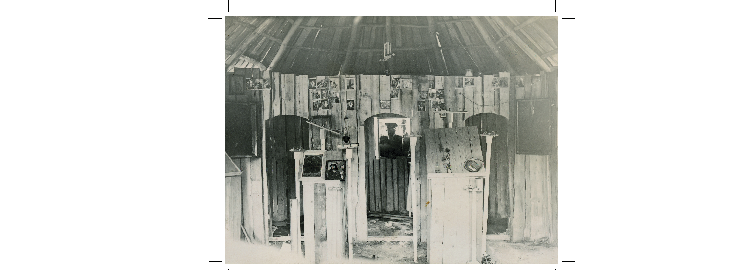
The Challenge
The Hidden Galleries project addresses a contested aspect of Europe’s common heritage, the problematic legacy of totalitarianism and its secret police. In the post Cold War-era, the communist and fascist pasts have become a battle ground in the search for historical truth and national memory. In 20th century Central and Eastern Europe, the secret police was one of the principal agencies deployed by both communist and right-wing dictatorships to eliminate undesirable groups from society, significant amongst which were the many undersirable and suspect religious communities.
But in doing this a paradoxical thing happened – testimonies, photographs, personal and sacred items, and the ephemera of religious life were preserved by the very state institutions whose role it was to delete them. Alongside these materials, the secret police produced their own representations of religious groups they were tasked with surveilling and controlling. The materials that were used to incriminate members of religious groups have a dual identity as today they also stand testimony to the creativity and resistance of these communities.
How should we approach this difficult aspect of cultural patrimony? What are the meanings and uses of the secret police archives in the deeply divided societies of contemporary postcommunist eastern europe? In exploring these questions, the Hidden Galleries project has three main aims. Firstly, to improve accessibility to difficult to locate materials throught the creation of a Digital Archive for use by scholars and communities. Secondly, to engage with communities that were targetted by the secret police in conversations about their lost cultural patrimony and its meaning for these communities today. Finally, to open up scholarly and societal debate on the legacies of communist and right-wing repression and how this has shaped post-communist societies.
The Research
Funded by a European Research Council award, eight researchers1 sifted through hundreds of thousands of pages of files in the secret police and other state archives in Romania, Hungary and the Republic of Moldova in order to find the uncatalogued, visual and material traces of communities that had been targeted by the state. A selection of these materials have been digitised and made accessible to researchers and communities in an online open-access Digital Archive.
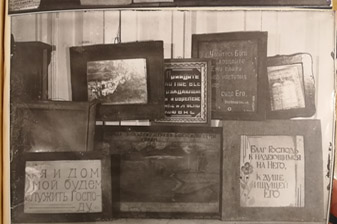 |
Secret police photograph of confiscated religious materials from Soviet Ukraine featured on the Hidden Galleries Digital Archive http://hiddengalleries.eu/digitalarchive/s/en/item/195 |
|---|
The various archival institutions have different regimes of access that impact on who gets to read a file, when and under what circumstances. Very rarely do members of the smaller religious communities that were targeted know what kind of materials can be found there or how to gain access. Following on from our archival work, whenever possible, the project researchers approached individuals and communities to discuss their experience of repression, their relationship to the archival materials that were stolen from them, to explain how to gain access and to invite them to participate in the project's public exhibitions taking place between November 2019 and June 2020 in Hungary, Romania and Moldova. In addition, the project team are producing a series of scholarly publications that address historical, visual methodological, anthropological and ethical questions in relation to the uses and meaning of the secret police archives.
The Impact
The secret police were mostly interested in people, not in preserving objects and images, but paradoxically that is precisely what they have done. Unintentionally, the secret police created the possibility for the personal artefacts and cultural patrimony of communities to experience a new life and for researchers to pose new questions. The opening of the secret police archives from the 1990s onwards was designed to give access to those who were the targets of the regime as a form of compensation but this has not been taken up by groups, geographically removed from archives located in capital cities or who lack knowledge and know-how related to accessing state institutions.
The Hidden Galleries project has made accessible for the first time a wide range of materials and resources that were previously the preserve of a small number of accredited researchers. Open access to these examples of visual and material religious items is designed to achieve two aims. Firstly, to encourage scholars to incorporate visual and material methodologies in their research on communist and fascist repression of religion. Secondly, to reconnect communities with aspects of their lost cultural patrimony.
“Everyone thinks that the archives are for researchers, not for them. But in fact, it’s very important for people to understand that the archives can be accessed! This project has motivated people to do more research. Your work is extremely valuable for us, it is as if we opened a box and now they can look inside it and discover more” (a member of the Old Calendarist Church, Romania)"
This second goal has achieved almost immediate results with members of religious communities having contacted the Principal Investigator and members of the research team by telephone and via facebook to discuss the materials we have found and placed online. These connections have developed into close partnerships with the project team helping communities (e.g. the Old Calendarist Church and the Reformed Church Choir from Ocna Sibiului) navigate access to the secret police archives as well as with communities contributing to the project team’s analyses of images and objects. As project curator Gabriela Nicolescu reflects, the process of selecting of objects and stories for the exhibition became a tool of research in itself while having the images blown up large on the wall, produces a different encounter with the visual material both for the researchers and our research participants.
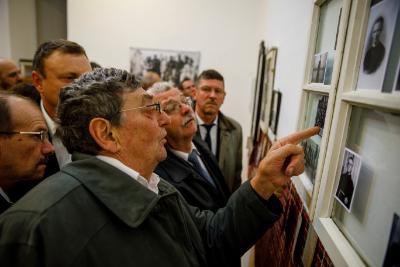 |
Members of the choir from Ocna Sibiului at the Hidden Galleries exhibition in Cluj-Napoca looking at photographs of their forebears that had been confiscated by the secret police |
|---|
In preparation for the public exhibitions that are taking place from November 2019 to June 2020, we have engaged with communities regarding the materials we found in the archives and together with them we pose some critical questions: To whom should these personal or sacred objects belong? How should they be preserved? And who should control access to them?
“They should be given back to the community, or at least given to museums that can preserve and exhibit them. The community should be the rightful owner of these items because it produced them, the believers made them. Not showing these items is not a right, it’s an abuse” (Tudorist believer)"
As well as giving access to religious communities and scholars, it is also the aim of the project’s public exhibitions to stimulate wider public debate on the legacy of totalitarianism and its impact on how society relates to questions of “otherness”. Working with groups of second level (highschool) and university students in Ireland, Hungary, Romania and Moldova, the project team is exploring, thorugh a series of interactive events, how the secret police used photographs, film and graphics to identify, incriminate and marginalise religious groups and to relate this to their own use of images on social media and to contemporary debates on privacy, access to personal data and the projection of “social danger” onto diverse segments of society.
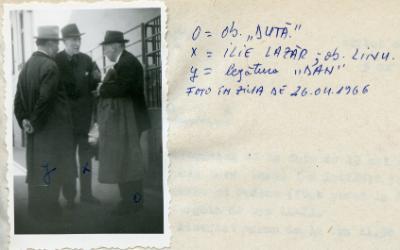 |
An example of surveilance photography form 1970s Romania featured in the Hidden Galleries Digital Archive http://hiddengalleries.eu/digitalarchive/s/en/item/385 |
|---|
The success of the key outputs of the project are the result of the establishment of a wide range partnerships and collaborations with institutions including the Council for the Study of the Securitate Archives in Romania, the Historical Archives of the Hungarian State Security in Hungary, the Museum of Art in Cluj-Napoca, Romania, the National Museum of Ethnography and Natural History in Chișinău, Moldova, the Open Society Archives in Budapest as well as several university departments and schools in the region.
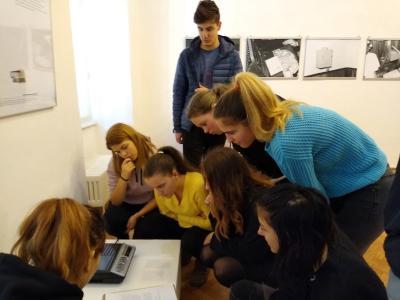 |
Students from the Art Highschool “Romulus Ladea” in Cluj-Napoca in the Hidden Galleries exhibtion. |
|---|
The Hidden Galleries project aspires to be open-ended encouraging wider circles of scholars and communities to become involved in enlarging the Digital Archive and taking the public exhibitions to other venues around the region.
For more information contact the project lead Dr James Kapaló at hiddengalleries@ucc.ie or you can follow the project on our website
http://hiddengalleries.eu/ and on facebook and twitter @hiddengalleries. Explore our Digital Archive at http://hiddengalleries.eu/digitalarchive/s/en/page/welcome.
